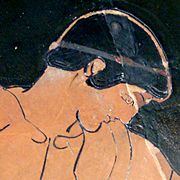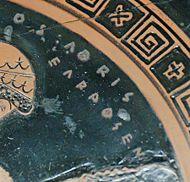
Douris (vase painter)
Encyclopedia

Red-figure pottery
Red-figure vase painting is one of the most important styles of figural Greek vase painting. It developed in Athens around 530 BC and remained in use until the late 3rd century BC. It replaced the previously dominant style of Black-figure vase painting within a few decades...
vase-painter and potter active ca. 500 to 460 BCE.
Work
He began his career painting for the potters Kleophrades and EuphroniosEuphronios
Euphronios was an ancient Greek vase painter and potter, active in Athens in the late 6th and early 5th centuries BC. As part of the so-called "Pioneer Group,"...
, before beginning a long collaboration with the potter Python. He signed 39 vases as a painter, also one as a potter and painter, and one vase as a potter only. Between 250 and 300 vases are ascribed to him. The majority of these vases are kylix
Kylix (drinking cup)
A kylix is a type of wine-drinking glass with a broad relatively shallow body raised on a stem from a foot and usually with two horizontal handles disposed symmetrically...
es, i.e. cups. His name seems to have been popular, since one finds it on other vases: it is reproduced on a cup by Onesimos
Onesimos (vase painter)
Onesimos was an ancient Athenian vase painter who flourished between 505 and 480 BC. He specialized in decorating cups, mostly of Type B, which comprise virtually all known examples of his work....
. On the basis of these signatures, his kalos inscription
Kalos inscription
The Kalos inscription was a form of epigraph found on Attic vases and graffiti in antiquity, common between 550 and 450 BC, and usually found on symposion vessels. The word καλός means "beautiful"; here it had an erotic connotation, and the inscription took the form of a youth's name, in the...
s, and of the subsidiary decoration of the vases, the art historian John Beazley
John Beazley
Sir John Davidson Beazley was an English classical scholar.Born in Glasgow, Scotland, Beazley attended Balliol College, Oxford, where he was a close friend of the poet James Elroy Flecker. After graduating in 1907, Beazley was a student and tutor in Classics at Christ Church, and in 1925 he...
divided his career into four principle periods:
Period 1
Is characterized by a full ornamentation of diverse border motifs. The preferred subjects are the symposiumSymposium
In ancient Greece, the symposium was a drinking party. Literary works that describe or take place at a symposium include two Socratic dialogues, Plato's Symposium and Xenophon's Symposium, as well as a number of Greek poems such as the elegies of Theognis of Megara...
, the komoi
Komos
The Komos was a ritualistic drunken procession performed by revelers in ancient Greece, whose participants were known as komasts. Its precise nature has been difficult to reconstruct from the diverse literary sources and evidence derived from vase painting....
(processions of drunks), and warriors. The period is marked out by the use of the kalos-inscription 'Chairestratos'. Beazley suggests that at this time Douris could have worked side by side with Onesimos in the same workshop.

Period 2
Douris' collaboration with Euphronios ends; from then on, he paints for the potter Python. Chairestratos remains the preferred kalos-inscription. Subsidiary decoration begins to recede, and the majority of the medallions do not have an edge. The favoured subjects are the scenes of youths and athletes. The hand of Douris is made clear from now on by the characteristic use of a kind of hook for the inner end of the collarbone. A characteristic piece of the period of the period is a psykterPsykter
A psykter is a type of Greek pot that is characterized by a bulbous body set on a high, narrow foot. It was used as a wine cooler. The psykter would be filled with wine, and then be placed in a krater full of cold water or ice....
(wine cooler) decorated with drunken satyrs, reproducing in a grotesque manner the different stages of intoxication.
Period 3
Douris' style is here at its most idiosyncratic. The edges of the medallion are characterized by the alternation of an element of a meander and squares; palmettes decorate the handles of the cup. The kalos-inscriptions 'Hippodamas' become prevalent; Douris' signatures become scarcer. Douris returns to the scenes of the symposium, and to depictions of warriors and school-scenes. A characteristic period of this period is the cup known as of the "pieta of Memnon": EosEos
In Greek mythology, Eos is the Titan goddess of the dawn, who rose from her home at the edge of Oceanus, the ocean that surrounds the world, to herald her brother Helios, the Sun.- Greek literature :...
carries the body of her son Memnon
Memnon (mythology)
In Greek mythology, Memnon was an Ethiopian king and son of Tithonus and Eos. As a warrior he was considered to be almost Achilles' equal in skill. During the Trojan War, he brought an army to Troy's defense. The death of Memnon echoes that of Hector, another defender of Troy whom Achilles also...
, killed by Achilles
Achilles
In Greek mythology, Achilles was a Greek hero of the Trojan War, the central character and the greatest warrior of Homer's Iliad.Plato named Achilles the handsomest of the heroes assembled against Troy....
during the Trojan War
Trojan War
In Greek mythology, the Trojan War was waged against the city of Troy by the Achaeans after Paris of Troy took Helen from her husband Menelaus, the king of Sparta. The war is among the most important events in Greek mythology and was narrated in many works of Greek literature, including the Iliad...
.
Period 4
Douris returns to a full ornamentation. The borders sometimes retain the period-3 ('Hippodamas-type') border of alternating stopt maeanders and saltire crosses, but gradually revert to the common type; the palmettes on the handles become complicated and of the motifs of the lotus appear in parallel. Douris' signatures disappear altogether and the kalos-inscriptions decrease in frequency; one finds 'Polyphrasmon' and 'HIketes'. The drawing quality degenerates in grace and force.
Sources
- John Beazler, "Attic Red-figure Vase-painters". Second edition, Oxford: The Clarendon Press, 1963.
- John BoardmanJohn BoardmanJack Melton Boardman, commonly known as John Boardman, is an American former professor of physics at Brooklyn College.- Academic career :...
. Athenian Red Figure Vases: The Archaic Period: A Handbook. London: Thames and Hudson, 1975. - Diana Buitron-Oliver. Douris. A Master-Painter of Athenian Red-Figure Vases. (in Kerameus, Vol. 9, 2005, online)
- Edmond Pottier and Jane Ellen Harrison (translated by Bettina Kahnweiler). Douris and the Painters of Greek Vases. London: J. Murray, 1908.
- The Getty Museum - Biography of Douris One of the most prolific vase-painters known, Douris worked as a vase-painter and occasionally as a potter in Athens in the early 400s B.C. He is known from almost forty signed vases, two of which he also potted. Altogether, almost three hundred vases have been attributed to him. Given that scholars estimate a less than 0.5% survival rate for Greek vases, Douris may have decorated approximately 78,000 vases in his career. Douris primarily decorated red-figure cups, but he also painted a few vessels of other forms and in other techniques, including white-ground. His scenes are about evenly divided between mythology and depictions of everyday life. He worked with a number of potters, including Kleophrades and Euphronios, but he seems to have had a regular collaboration with Python. Onesimos depicted a cup signed by Douris on one of his vases, and there is even an ancient forgery of Douris's signature. These unusual references attest to Douris's significant influence among contemporary vase-painters.
Source of translation
- This page is a translation of the French Wikipedia article :fr:Douris (peintre), a laurel to its authors.

